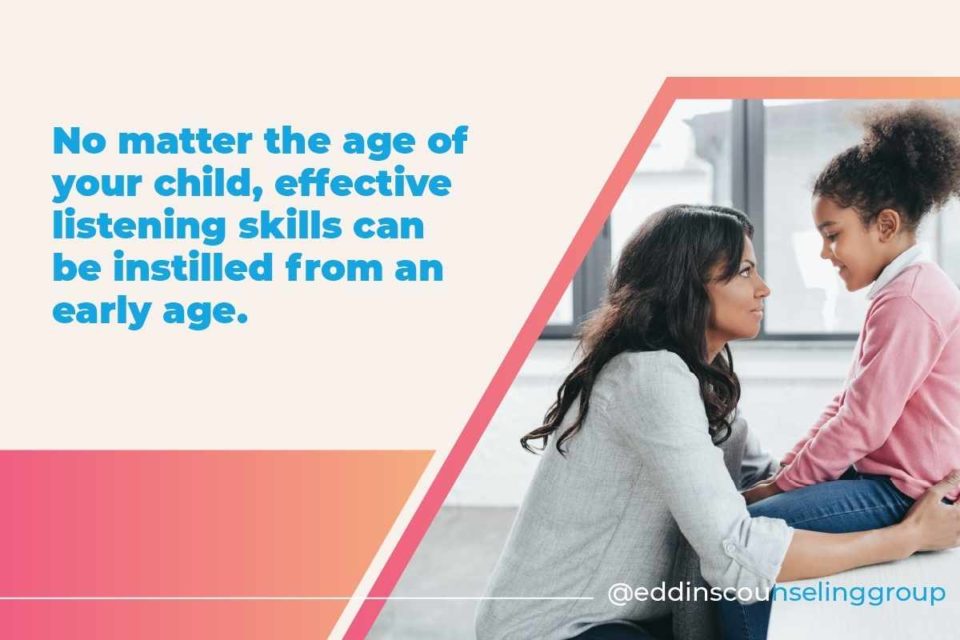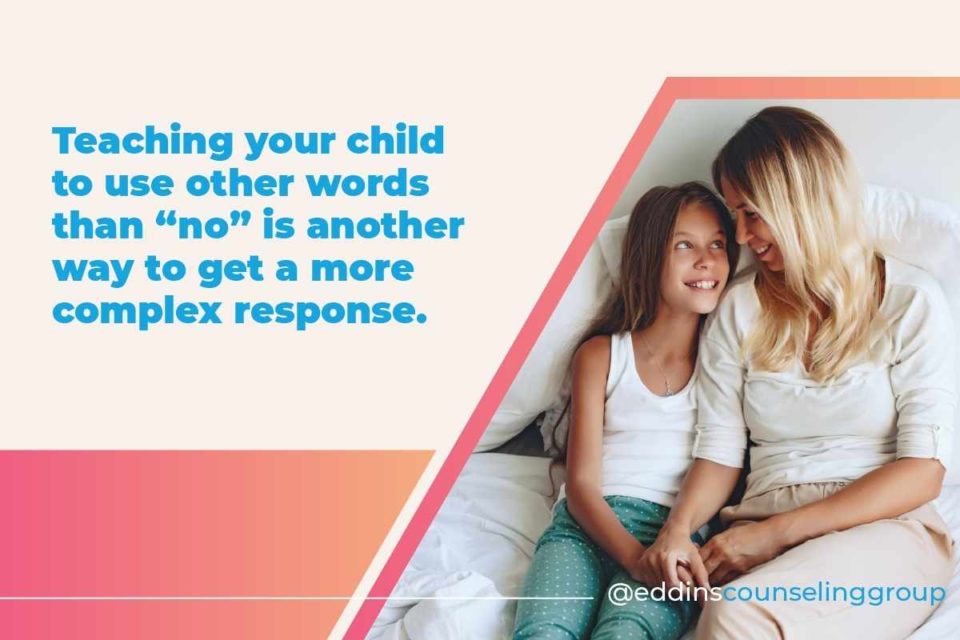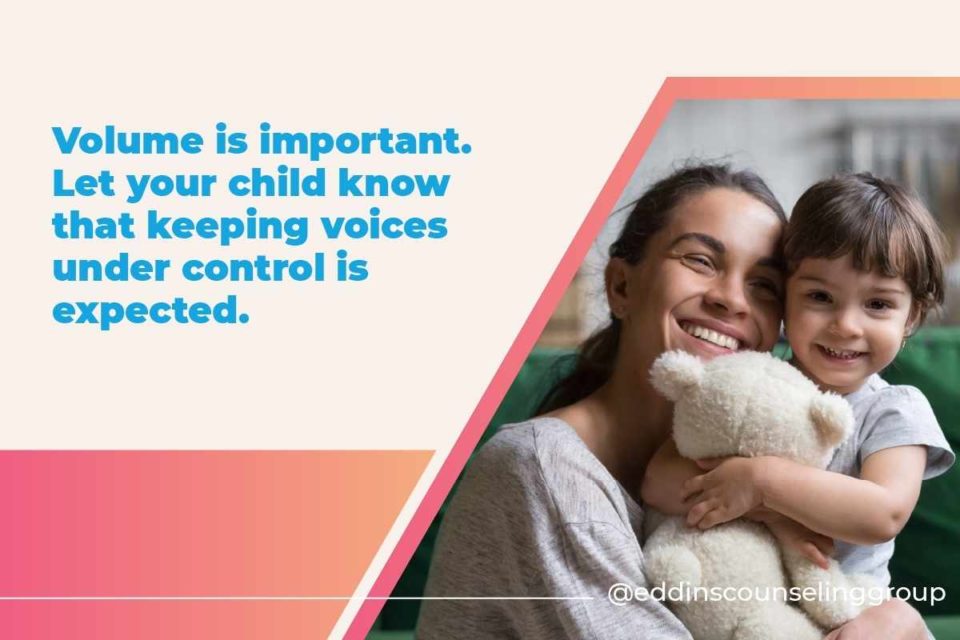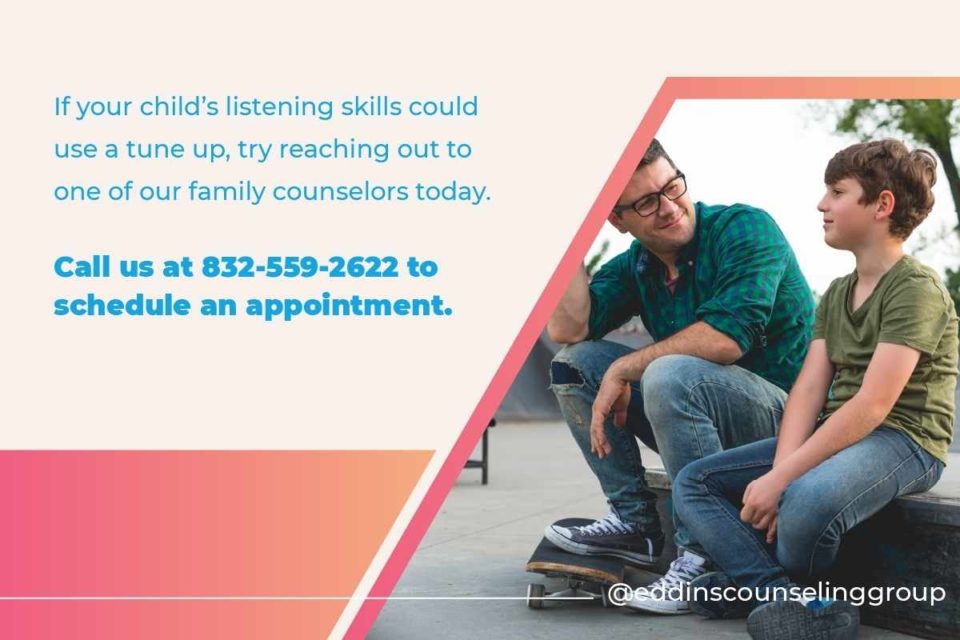September 9, 2022
15 Ways to Speak So Your Child Will Listen
Written by Sara Lane
Posted in Child Counseling, Parenting & Family, Tools & Exercises and with tags: children, listening, parenting, stress management, teens
15 Ways to Teach Your Child Listening Skills: How to Communicate So Your Kids Will Listen
If you’re a parent, you know how frustrating it can be to get your child to listen. At times, getting your child to communicate with you can feel outright frustrating and discouraging.
No matter the age of your child, effective listening skills can be instilled from an early age.
Even if you are raising a strong-willed child, your early communication training can make a significant difference in your child’s ability to communicate effectively.
Rather than telling your child “no”, here are some effective strategies and scripts you can use instead to get buy-in from your child and build connection. A positive connection is more likely to lead to a positive outcome.

1. Provide Wait Time
Just as we make time in our busy schedules to complete important tasks, it can be helpful to give your child “wiggle room” to complete their tasks as well. For example, if you ask your child to start doing the dishes, consider allowing them to finish saving their video game / playing with their legos for 5 minutes more / etc.
By allowing your child wait time to complete their tasks, you foster autonomy that they will use in the future to complete instructions in a timely manner.
2. Make It Visual
If your child is having difficulty following through with instructions, try showing them what you’d like them to do. For example, if you ask them to put their toys away and your child is simply shoving toys into a corner rather than putting them in the toy box, demonstrate what the expectations are when putting toys away.
3. Get Connected
Using phrases that connect with your child’s emotion in the moment shows that you understand how your child is feeling. Without throwing in the towel to the instructions you’ve given them, you can foster emotional connectedness by saying:
- “I understand that taking out the trash is new for you, and maybe it feels a little scary trying something new.”
- “I see you are angry…”
- “I hear you saying you really wanted to play before dinner. I know that you feel disappointed, and that makes me sad.”
4. Get Closer
Closing the distance between you and your child puts you on their level. By getting physically closer, you communicate instructions in a more personal way that encourages them to respond well. You can do this by:
- Lowering down to eye level
- Putting a hand on their shoulder
- Avoiding yelling from another room
- Making eye contact

5. Give Clear Instructions
Instead of saying “Stop that!” “Quit” or “No!”, try saying phrases like “What you are doing is bothering your sister…” or “It is not ok to hit your brother. You need to apologize by…”
Clear instructions communicate to your child your expectations, and what actions you want them to take next.
Watch our webinar: On Being a Parent
6. Tune in to Your Toddler
During communication, it’s important to make sure that your child is actually hearing you. Are they simply watching you without comprehending what you’re saying?
To make sure they’ve actually heard you and understand what action is needed, ask them to repeat your words back to you. This ensures that they’ve internalized the instructions you’ve given them, and know how to respond.
7. Getting Investment from Your Child
Ask your child to connect with your instructions by asking them how they are feeling.
- Are they excited to complete ________?
- Are there any obstacles they have to overcome in order to do ________?
Let your child know that you want their feedback, and allow that emotional connection to let them know you’re on the same team. This helps your child understand that the instructions are shared goals between the both of you.
8. Teach Alternatives to “No”
While saying “no” is an important verbal tool to keep in your toolbox, it may not be effective to use in every situation. When communicating with strong-willed children, keep in mind these alternatives to using “no”:
- Get Playful | “I wonder if your lego guy could do _______ chore. What do you think?”
- Use Curiosity | “What do you think would happen if…?”
- Make a Plan Together | “I see you are struggling with your to-do list. Let’s plan what you need to do together so you know your next steps.”
- Use “I Wonder If” Statements | “I wonder what would happen if we never did the dishes…”
- Offer Choices | “Would you like to start picking up toys after lunch or right now?”
- Give Positive Alternatives | “Instead of jumping on the furniture which could hurt the couch and you, we can jump on the trampoline outside.”
- Connect with Emotions | “I see you are angry…”

To do this, try giving your child emotional phrase options like:
- “I don’t like that because…”
- “I’m struggling with…”
- “I’m upset because…”
- “I’m not sure how to get started on…”
- “Is it ok if…”
- “I’m having a hard time because…”
- “Can I do that later?”
- “I need to find a good stopping point and then I will do…”
- “I’m worried that if I stop doing what I’m doing right now that _______ will happen.”
- “I’m almost done building ________ and then I will do my chore, if I have your permission.”
9. Play Listening Games
Practice essential listening skills by playing listening games together. These can teach your child how to listen intuitively and watch for details.
More listening games can be found here.
10. Allow Them to Speak Their Mind
Letting your child tell you their feelings is an important part of the listening process. By allowing for feedback, you communicate that your child’s thoughts and feelings are important to you.
This allows for transparency in later development, and a better understanding of their thought processes in response to instructions.
11. What Is Your Child Trying to Tell You?
Anger can sometimes look like a tantrum, but is there more to it?
When your child doesn’t respond immediately, try to tune in to what might be going on in their mind. Are they scared? Frustrated? Feeling out of control?
By allowing your child to communicate their emotional response to your instructions, you imply that their thoughts and feelings are important to you.
With younger children, it may be important to infer what you think is happening. Teaching emotional language from an early age is an important way to get more detailed feedback later in development.
12. Whisper
Volume is important. Let your child know that keeping voices under control is expected.
If you feel that your child is not hearing you, try keeping your voice to a whisper to train your child to actively listen when you are speaking.

13. Define “Not Listening”
Make clear definitions of what “not listening” looks like when you are giving instructions. This can include:
- Posture and body language of your child
- Communication volume
- Distractions are a no-go
- No playing with toys or TV while mom or dad is speaking
- Response time for your child to take action to your instructions
By making these clear, you set foundational expectations for how you want your child to listen.
Watch our webinar: Tools for Strengthening the Parent Child Relationship
14. Make Your Child Part of the Plan
If your child isn’t sure where to start, give your child an action plan that you create together. For example, if your child is asked to clean their room, you can try breaking up the chore into smaller sections.
Let your child know that you want them to succeed, and create a game plan together to get their chores done.
15. Create Systems & Routines
Children enjoy consistency.
If you would like the dishes to be done every evening after supper, make this a fun routine. Add in silly dish-washing songs, walk down memory lane, or discuss their day.
By making these chores fun and systematic, you may avoid some headaches in the future.

Need a Hand?
If your child’s listening skills could use a tune up, try reaching out to one of our child counselors today. Together, you can share pitfalls and poor behavior, and receive support in active listening skills training with your child.
Contact us today or book your first appointment at Eddins Counseling Group and get started with one of our Houston, Montrose, or Sugar Land therapists today.





















